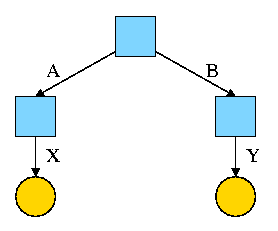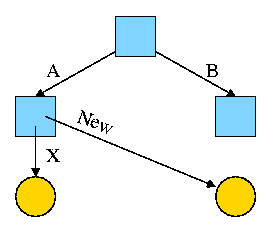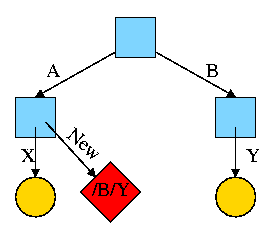Operating Systems
2000-01 Fall
M 5:00-6:50
Ciww 109
Allan Gottlieb
gottlieb@nyu.edu
http://allan.ultra.nyu.edu/~gottlieb
715 Broadway, Room 1001
212-998-3344
609-951-2707
email is best
================ Start Lecture #10
================
4.3.3: Shared files (links)
- ``Shared'' files is Tanenbaum's terminology.
- More descriptive would be ``multinamed files''.
- If a file exists, one can create another name for it (quite
possibly in another directory).
- This is often called creating a (or another) link to the file.
- Unix has two flavor of links, hard links and
symbolic links or symlinks.
- Dos/windows has symlinks, but I don't believe it has hard links.
- These links often cause confusion, but I really believe that the
diagrams I created make it all clear.

Hard Links
- Symmetric multinamed files.
- When a hard like is created another name is created for
the same file.
- The two names have equal status.
- It is not, I repeat NOT true that one
name is the ``real name'' and the other is ``just a link''.
Start with an empty file system (i.e., just the root directory) and
then execute:
cd /
mkdir /A; mkdir /B
touch /A/X; touch /B/Y
We have the situation shown on the right.
Note that names are on edges not nodes.
When there are no multinamed files, it doesn't much matter.

Now execute
ln /B/Y /A/New
This gives the new diagram to the right.
At this point there are two equally valid name for the right hand
yellow file, /B/Y and /A/New. The fact that /B/Y was created first is
NOT detectable.
- Both point to the same inode.
- Only one owner (the one who created the file initially).
- One date, one set of permissions, one ... .

Assume Bob created /B and /B/Y and Alice created /A, /A/X, and /A/New.
Later Bob tires of /B/Y and removes it by executing
rm /B/Y
The file /A/New is still fine (see third diagram on the right).
But it is owned by Bob, who can't find it! If the system enforces
quotas bob will likely be charged (as the owner), but he can neither
find nor delete the file (since bob cannot unlink, i.e. remove, files
from /A)
Since hard links are only permitted to files (not directories) the
resulting file system is a dag (directed acyclic graph). That is there
are no directed cycles. We will now proceed to give away this useful
property by studying symlinks, which can point to directories.
Symlinks
- Asymmetric multinamed files.
- When a symlink is created another file is created, one
that points to the original file.

Again start with an empty file system and this time execute
cd /
mkdir /A; mkdir /B
touch /A/X; touch /B/Y
ln -s /B/Y /A/New
We now have an additional file /A/New, which is a symlink to /B/Y.
- The file named /A/New has the name /B/Y as its data
(not metadata).
- The system notices that A/New is a diamond (symlink) so reading
/A/New will return the contents of /B/Y (assuming the reader has read
permission for /B/Y).
- If /B/Y is removed /A/New becomes invalid.
- If a new /B/Y is created, A/New is once again valid.
- Removing /A/New has no effect of /B/Y.
- If a user has write permission for /B/Y, then writing /A/New is possible
and writes /B/Y.
The bottom line is that, with a hard link, a new name is created
that has equal status to the original name. This can cause some
surprises (e.g., you create a link but I own the file).
With a symbolic link a new file is created (owned by the
creator naturally) that points to the original file.
Question: Consider the hard link setup above. If Bob removes /B/Y
and then creates another /B/Y, what happens to /A/X?
Answer: Nothing. /A/X is still a file with the same contents as the
original /B/Y.
Question: What about with a symlink?
Answer: /A/X becomes invalid and then valid again, this time pointing
to the new /B/Y.
(It can't point to the old /B/Y as that is completely gone.)

What about symlinking a directory?
cd /
mkdir /A; mkdir /B
touch /A/X; touch /B/Y
ln -s /B /A/New
Is there a file named /A/New/Y ?
Yes.
What happens if you execute cd /A/New/.. ?
- Answer: Not clear!
- Clearly you are changing directory to the parent directory of
/A/New. But is that /A or /?
- The command interpreter I use offers both possibilities.
- cd -L /A/New/.. takes you to A (L for logical).
- cd -P /A/New/.. takes you to / (P for physical).
- cd /A/New/.. takes you to A (logical is the default).
What did I mean when I said the pictures made it all clear?
Answer: From the file system perspective it is clear. Not always so
clear what programs will do.
4.3.4: Disk space management
All general purpose systems use a (non-demand) paging
algorithm for file storage. Files are broken into fixed size pieces,
called blocks that can be scattered over the disk.
Note that although this is paging, it is never called paging.
The file is completely stored on the disk, i.e., it is not
demand paging.
- Actually it is more complicated as various optimizations are
performed to try to have consecutive blocks of a single file stored
consecutively on the disk.
- One can imagine systems that store only parts of the file on disk
with the rest on tertiary storage (some kind of tape).
- This would be just like demand paging.
- Perhaps NASA does this with their huge datasets.
- Caching (as done for example in microprocessors) is also the same
as demand paging.
- We unify these concepts in the computer architecture course.
Choice of block size
- We discussed this before when studying page size.
- Current commodity disk characteristics (not for laptops) result in
about 15ms to transfer the first byte and 10K bytes per ms for
subsequent bytes (if contiguous).
- We will explain the following terms in the I/O chapter.
- Rotation rate is 5400, 7600, or 10,000 RPM (15K just now
available).
- Recall that 6000 RPM is 100 rev/sec or one rev
per 10ms. So half a rev (the average time for to rotate to a
given point) is 5ms.
- Transfer rates around 10MB/sec = 10KB/ms.
- Seek time around 10ms.
- This favors large blocks, 100KB or more.
- But the internal fragmentation would be severe since many files
are small.
- Multiple block sizes have been tried as have techniques to try to
have consecutive blocks of a given file near each other.
- Typical block sizes are 4KB anf8KB.
Storing free blocks
There are several possibilities.
- An in-memory bit map.
- One bit per block
- If blocksize=4K, 1 bit per 32K bits
- So 32GB disk (potentially all free) needs 1MB ram
- Bit map paged in.
- Linked list with each free block pointing to next: Extra disk
access per block.
- Linked list with links stored contiguously, i.e. an array of
pointers to free blocks. Store this in free blocks and keep one in memory.
4,3.5: File System reliability
Bad blocks on disks
Not so much of a problem now. Disks are more reliable and, more
importantly, disks take care of the bad blocks themselves. That is,
there is no OS support needed to map out bad blocks. But if a block
goes bad, the data is lost (not always).
Backups
All modern systems support full and
incremental dumps.
- A level 0 dump is a called a full dump (i.e., dumps everything).
- A level n dump (n>0) is called an incremental dump and the
standard unix utility dumps
all files that have changed since the previous level n-1 dump.
- Other dump utilities dump all files that have changed since the
last level n dump.
- Keep on the disk the dates of the most recent level i dumps
for all i. In Unix this is traditionally in /etc/dumpdates.
- What about the nodump attribute?
- Default policy (for Linux at least) is to dump such files
anyway when doing a full dump, but not dump them for incremental
dumps.
- Another way to say this is the nodump attribute is honored for
level n dumps if n>1.
- The dump command has an option to override the default policy
(can specify k so that nodump is honored for level n dumps if n>k).
Consistency
- Fsck (file system check) and chkdsk (check disk)
- If the system crashed, it is possible that not all metadata was
written to disk. As a result the file system may be inconsistent.
These programs check, and often correct, inconsistencies.
- Scan all inodes (or fat) to check that each block is in exactly
one file, or on the free list, but not both.
- Also check that the number of links to each file (part of the
metadata in the file's inode) is correct (by
looking at all directories).
- Other checks as well.
- Offers to ``fix'' the errors found (for most errors).
- ``Journaling'' file systems
- An idea from database theory (transaction logs).
- Eliminates the need for fsck.
- NTFS has had journaling from day 1.
- Many Unix systems have it. IBM's AIX converted to journaling
in the early 90s.
- Linux does not yet have journaling, a serious shortcoming. It
is under very active development.
- FAT does not have journaling.
4.3.6 File System Performance
Buffer cache or block cache
An in-memory cache of disk blocks
- Demand paging again!
- Clearly good for reads as it is much faster to read memory than to
read a disk.
- What about writes?
- Must update the buffer cache (otherwise subsequent reads will
return the old value).
- The major question is whether the system should also update
the disk block.
- The simplest alternative is write through
in which each write is performed at the disk before it declared
complete.
- Since floppy disk drivers adopt a write through policy,
one can remove a floppy as soon as an operation is complete.
- Write through results in heavy I/O write traffic.
- If a block is written many times all the writes are
sent the disk. Only the last one was ``needed''.
- If a temporary file is created, written, read, and
deleted, all the disk writes were wasted.
- DOS
- The other alternative is write back in which
the disk is not updated until the in-memory copy is
evicted (i.e., the replacement question).
- Much less write traffic than write through.
- Trouble if a crash occurs.
- Used by Unix and others for hard disks.
- Can write dirty blocks periodically, say every minute.
This limits the possible damage, but also the possible gain.
- Ordered writes. Do not write a block containing pointers
until the block pointed to has been written. Especially if
the block pointed to contains pointers since the version of
these pointers on disk may be wrong and you are giving a file
pointers to some random blocks.
- Research in ``log-structured'' file systems tries to make all
writes sequential (i.e., writes are treated as if going to a log file).
Homework: 12.
4.4: Security
Very serious subject. Could easily be a course in itself. My
treatment is very brief.
4.4.1: Security environment
- Accidental data loss
- Fires, floods, etc
- System errors
- Human errors
- Intruders
- Sadly an enormous problem.
- The NYU ``greeting'' no longer includes the word ``welcome''
since that was somehow
interpreted as some sort of license to break in.
- Indeed, the greeting is not friendly.
- It once was.
- Below I have a nasty version from a few years ago.
~~~~~~~~~~~~~~~~~~~~~~~~~~~~~~~~~~~~~~~~~~~~~~~~~~~~~~~~~~~~~~~~~~~~~~~~~~~~
WARNING: UNAUTHORIZED PERSONS ........ DO NOT PROCEED
~~~~~~~ ~~~~~~~~~~~~~~~~~~~~ ~~~~~~~~~~~~~~
This computer system is operated by New York University (NYU) and may be
accessed only by authorized users. Authorized users are granted specific,
limited privileges in their use of the system. The data and programs
in this system may not be accessed, copied, modified, or disclosed without
prior approval of NYU. Access and use, or causing access and use, of this
computer system by anyone other than as permitted by NYU are strictly pro-
hibited by NYU and by law and may subject an unauthorized user, including
unauthorized employees, to criminal and civil penalties as well as NYU-
initiated disciplinary proceedings. The use of this system is routinely
monitored and recorded, and anyone accessing this system consents to such
monitoring and recording. Questions regarding this access policy or other
topics should be directed (by e-mail) to comment@nyu.edu or (by phone) to
212-998-3333.
~~~~~~~~~~~~~~~~~~~~~~~~~~~~~~~~~~~~~~~~~~~~~~~~~~~~~~~~~~~~~~~~~~~~~~~~~~~~





